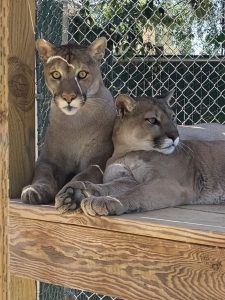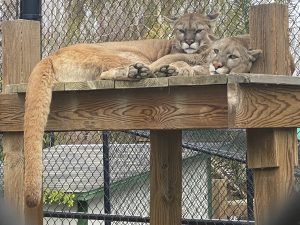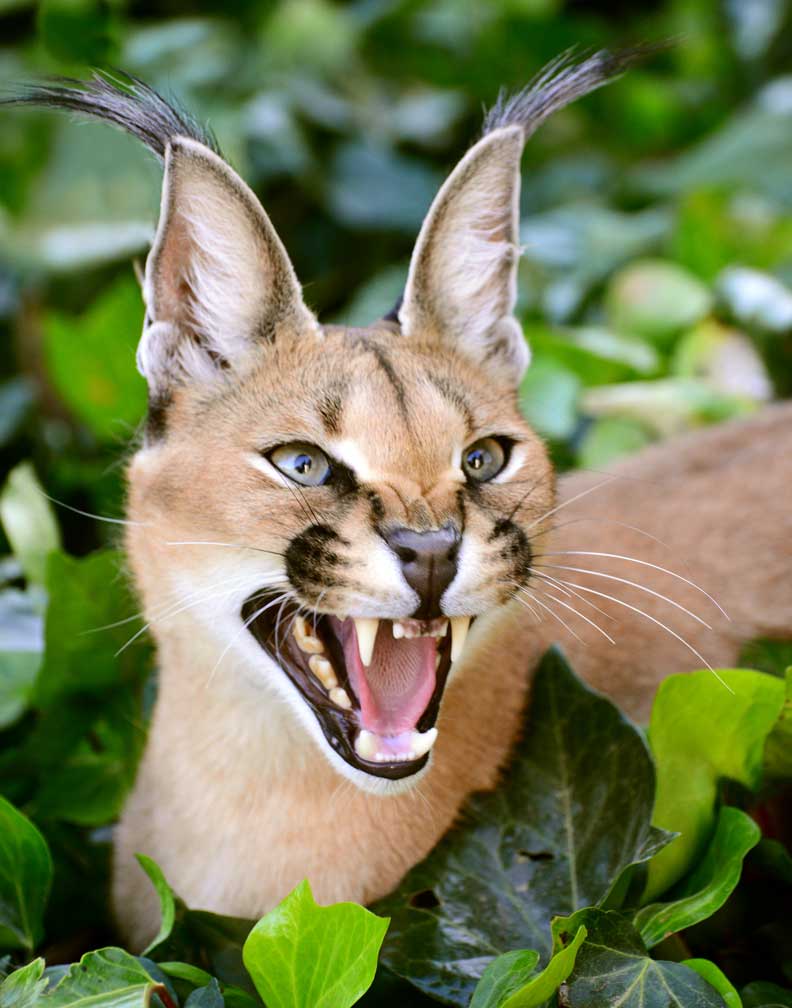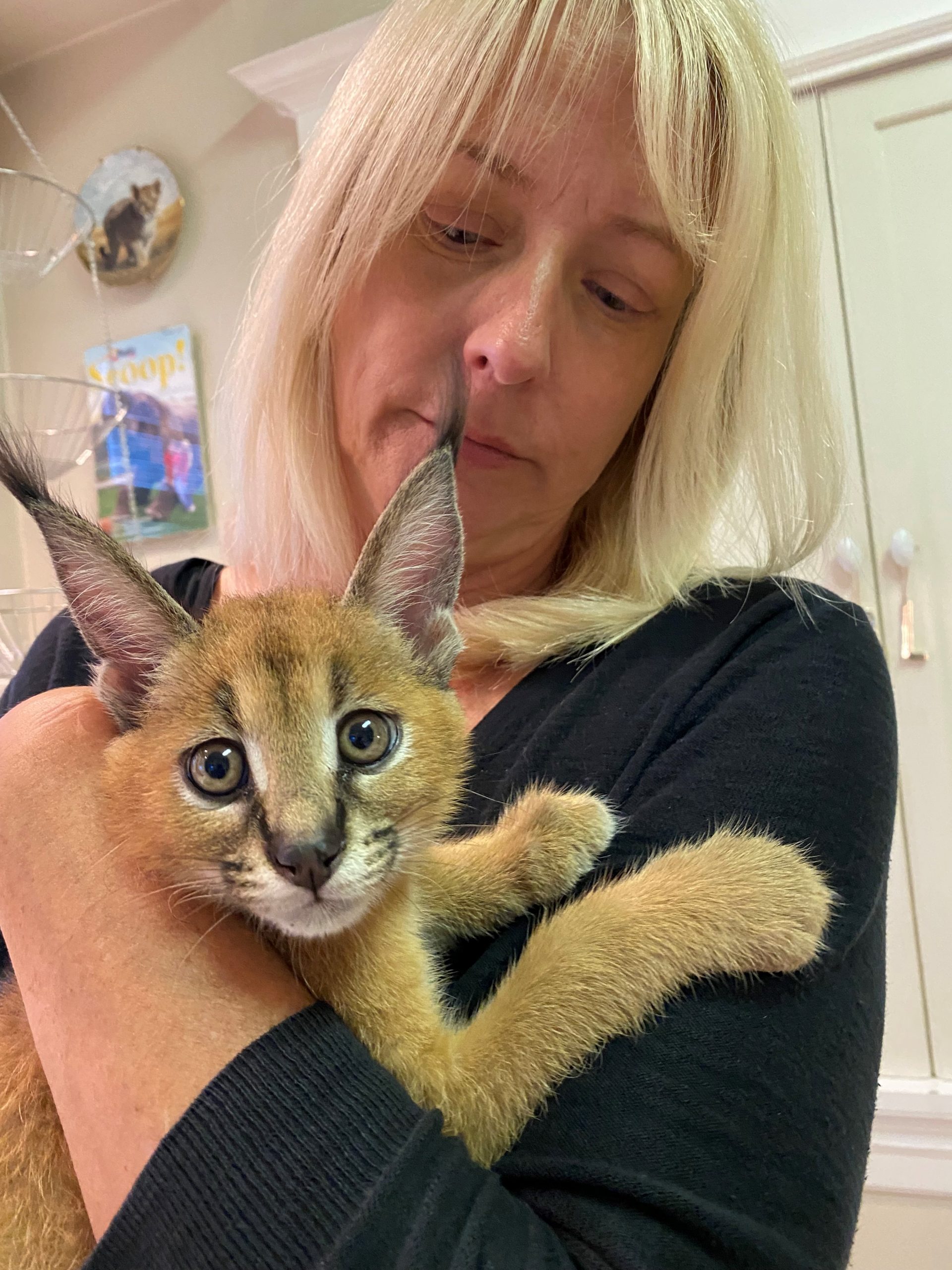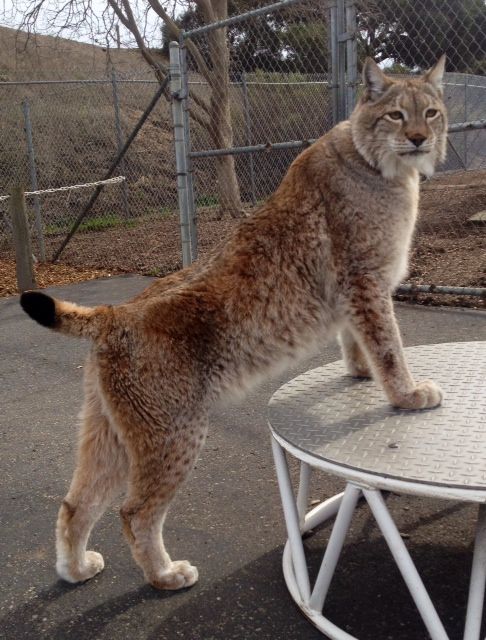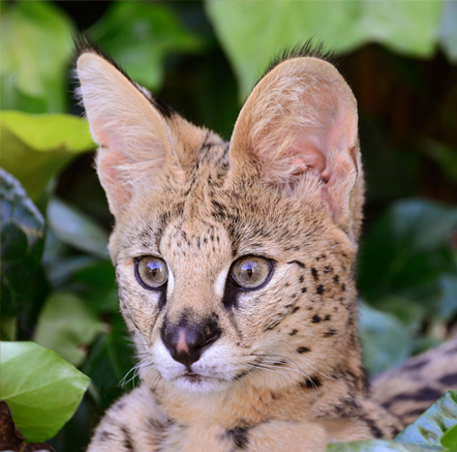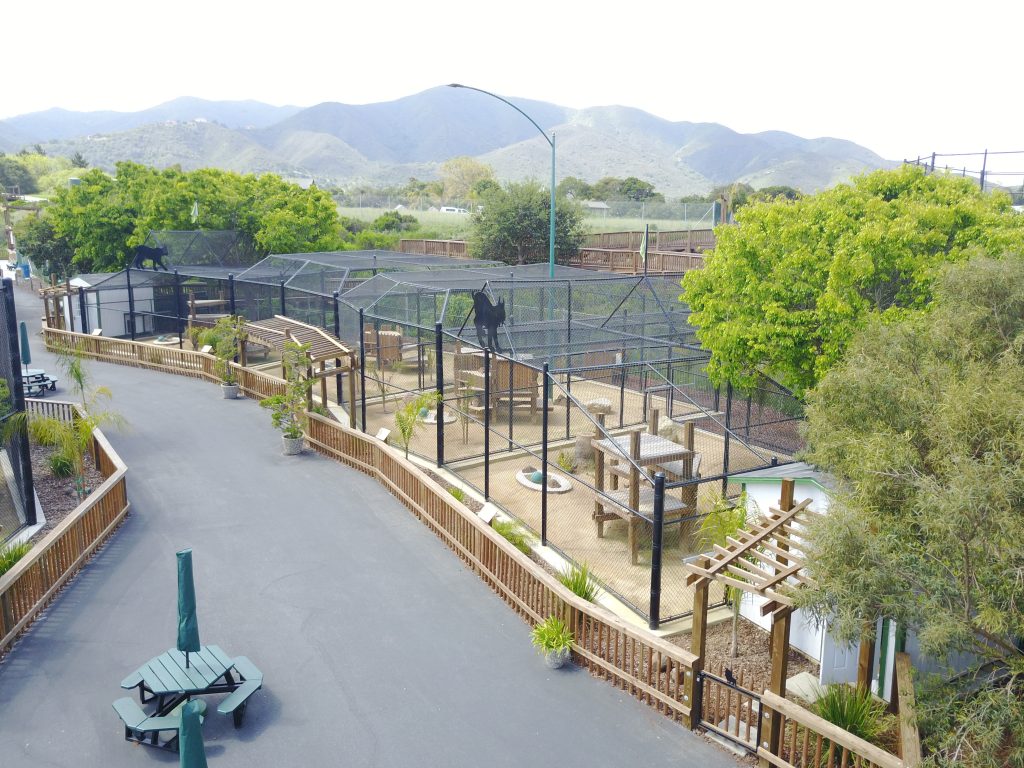
We could not be more proud of the new habitats our small cats are now enjoying. Please come see the magic of these animals up close.

Our Cougars
The cougar is also commonly known as the mountain lion, puma, Florida panther, catamount, and several other Native American names. Its range, from the Canadian Yukon to the southern Andes of South America, is the greatest of any large wild terrestrial mammal in the Western Hemisphere. Cougars are the only lion native to the United States making us one of only three countries that have lions native to their lands. They are the largest predatory cat in the United States and very distributed throughout the country. Like almost all cats, the cougar is a solitary animal. Only mothers and kittens live in groups, with adults meeting only to mate. It is a secretive animal and is most active around dawn and dusk.
Our three cougars today are Johnny, Cosmo and Loretta, all named from our zoo director/founder Charlie Sammut’s favorite motion picture, “Moonstruck” staring Nicholas Cage and Cher. Charlie is very defensive of cougars in our country as he feels we should be very proud to one of very few countries that have a lion making them a national treasure to be valued and protected.
Cosmo came to The Monterey Zoo before it was actually called Monterey Zoo. He did several film and television projects, including a commercial for BYU University. Some big cats learn to embrace and enjoy working on such productions, some do not. Cosmo truly enjoyed the experience.
If zookeepers across the country agreed on only one thing, it would be that few animals are “cuter” as cubs than the cougar. Johnny arrived in July, 2017 as a twelve week old cub and indeed lived up to that billing.
Diet
The cougar will eat any animal it can catch, from insects to large mammals. Like all cats, it is an obligate carnivore, meaning it needs to feed exclusively on meat to survive.
Facts
Height: 2 to 3 feet (at shoulder)
Mass: 120 to 220 pounds (male), 64 to 140 pounds (female)
Lifespan: 8 to 13 years (in the wild)
Conservation Status
The International Union for Conservation of Nature (IUCN) currently lists the cougar as a “least concern” species, but there are still worries. Conservation threats to the species include persecution as a pest animal, environmental degradation and habitat fragmentation and depletion of their prey base.
Did you know?
Only females are involved in parenting. Female cougars are fiercely protective of their cubs, and have been seen to successfully fight off animals as large as Grizzly bears in their defense.
Our Caracals (Caracal caracal)
Bartley is small cat with a BIG attitude, which is exactly what you have to be when you’re a small cat on the African Plains. But our little Bartley does a spectacular job as an ambassador for his wild counter parts in our educational programs.
Sometimes called the African Lynx or desert lynx, these cats are about three feet long , with a foot-long tail and reddish brown fur, except for a white chin, throat and belly, and a black line running from each eye to the nose. Caracals are mostly solitary, nocturnal animals that live in Northern Africa, the Arabian Peninsula and Southwestern Asia.
Diet
Caracals are strict carnivores, eating mostly rodents, birds and small deer.
Facts
Height: 16 to 20 inches (at shoulder)
Mass: 26 pounds
Lifespan: 12 years (in the wild)
Conservation Status
The International Union for Conservation of Nature (IUCN) currently lists the caracal as a “least concern” species.
Did you know?
Caracals’ ears are each controlled by about 20 muscles to help these hunters better determine where prey is hiding.
Our Siberian Lynx (Lynx lynx)
As small exotic cats go, many professional animal trainers would argue that the Siberian Lynx is one of the most tractable cats to work with. Our lynx, Nadia, has been an extremely instrumental aspect of our education programs and backs up the above argument. Many guests have booked one of our private full contact tours just to meet and spend time with Nadia.
The lynx is a medium-sized cat native to Siberia, Asia and Eastern Europe. Although they may hunt during the day when food is scarce, the Eurasian lynx is mainly nocturnal and crepuscular (active during dawn and dusk), and spends most days sleeping in dense thickets or other places of concealment. It lives solitarily as an adult.
Diet
Lynx prey largely on small to fairly large sized mammals and birds. Although taking on larger prey presents a risk to the animal, the bounty provided by killing them can outweigh the risks.
Facts
Height: 24 to 30 inches (at shoulder)
Mass: 40 to 66 pounds (male), 18 to 46 pounds (female)
Lifespan: 17 years (in the wild)
Conservation Status
The largest threat facing this Lynx is the destruction of its prey base, loss of habitat and the increasing urbanization of Western Europe.
Did you know?
It has powerful, relatively long legs, with large webbed and furred paws that act like snowshoes.
Our Servals (Leptailurus serval)
Most animals at Monterey Zoo enjoy the benefit of being hand-raised and cared for from an early age in the homes of our keepers. Skully was one of those animals. We believe that although captivity can never offer all that the wild might, a relationship with humans is one we can and should promote when possible.
The serval also known as the tierboskat, is a wild cat found in Africa. It is characterized by a small head, large ears, a golden-yellow to buff coat spotted and striped with black, and a short, black-tipped tail. The serval has the longest legs of any cat relative to its body size. A solitary animal, there is little social interaction among servals except in the mating season, when pairs of opposite sexes may stay together. The only long-lasting bond appears to be of the mother and her cubs, which leave their mother only when they are a year old.
Diet
The serval is an omnivore that preys on rodents, small birds, frogs, insects and reptiles, and also feeds on grasses that can help with digestion.
Facts
Height: 21 to 24 inches (at shoulder)
Mass: 18 to 40 pounds
Lifespan: 20 years
Conservation Status
The population is generally considered stable. The International Union for Conservation of Nature (IUCN) lists the serval as a “least concern” species.
Did you know?
In 1986, a healthy hybrid kitten between a male serval and a female domestic cat was born; this kitten was larger than a typical domestic kitten and resembled its father in its coat pattern, but It appeared to have inherited a few domestic traits, such as tameness, from its mother. Over the years, savannah cats have gained popularity as pets.
Our Bobcat (Lynx rufus)
Many of the animals at Monterey Zoo come to us from other walks of life, to include our bobcats, one of which was participating in an education/film/tv facility in Southern California while the other was non-releasable animal brought to us by the California Dept. of Fish and Wildlife.
The Bobcat ranges from Southern Canada, throughout the United States and into Mexico. Two sub-species are recognized, one east of the Great Plains and the other west of the Great Plains. It derives its name from its obvious bobbed or stubby tail. On average, it is the smallest of the Lynx genus.
Diet
The serval is a carnivore that preys primarily on rodents, rabbits and hares, insects, chickens, geese and other birds. They have been known to take small deer and domestic animals.
Facts
Length: 49 inches (at shoulder)
Mass: 14 to 40 pounds
Lifespan: 20 years
Conservation Status
Its conservation status is of least concern however it has been hunted extensively in some areas for both sport and fur and is therefore declining in those areas.
Did you know?
Stories featuring the bobcat, in many variations, are found in several cultues of North America. In a Shawnee Indian tale, the bobcat is outwitted by a rabbit which gives rise to its spots. After trapping the rabbit in at tree, the bobcat is persuaded to build a fire, only to have the embers scattered on its fur, leaving it singed with dark brown spots.


